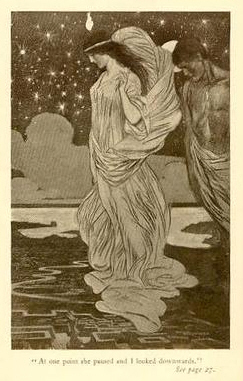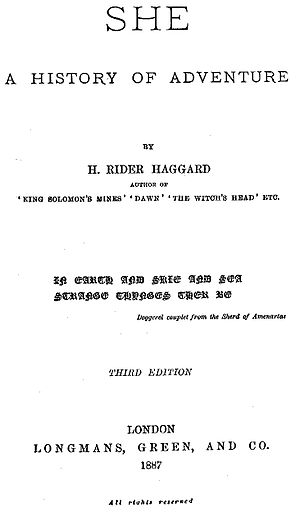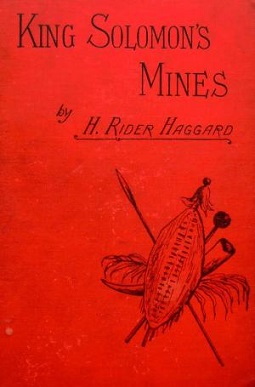Ayesha (novel)
| Ayesha | |
|---|---|
 First edition cover pub. by "Ward Lock"
|
|
| Author | H. Rider Haggard |
| Country | United Kingdom |
| Language | English |
| Series | Ayesha Series |
| Genre | Fantasy, Adventure novel |
| Publisher | Ward Lock |
|
Publication date
|
1905 |
| Media type | Print (hardback & paperback) |
| Pages | 384 pp |
| ISBN | NA |
| Preceded by | She |
| Followed by | She and Allan |
Ayesha, the Return of She is a gothic-fantasy novel by the popular Victorian author H. Rider Haggard, published in 1905, as a sequel to his far more popular and well known novel, She. It was serialised in the Windsor Magazine in 1904-5.
Ayesha, the Return of She 「女王の復活」は、彼のはるかにポピュラーでより有名な小説、「洞窟の女王」の続編として、1905年に出版された人気のあるビクトリア朝著者H・ライダー・ハガードの中世の空想の小説です。
それは1904-5年のウィンザー・マガジンの中で連続しました。
Its significance was recognised by its republication by the Newcastle Publishing Company as the fourteenth volume of the celebrated Newcastle Forgotten Fantasy Library series in October 1977.
その重要性は、1977年10月にニューカースル出版社の有名な「忘れられたファンタジー・ライブラリー」のシリーズの第14巻(再版)によって認められました。
In the introduction, Sir H. Rider Haggard links the name Ayesha to Muhammad's wives, and the Arabic name (Arabic: عائشة, ʻĀʼishah, pronounced [ˈʕaːʔiʃa]), stating that it should be pronounced "Assha" /ˈɑːʃə/,[1] although the pronunciation A·ye·sha /ɑːˈjiːʃə/ is perhaps more common.
イントロダクションでは、H・ライダー・ハガードサーは、発音されるべきであると述べて、ムハンマドの妻への名前アーイシャおよびアラビアの名前(アラビア:عائشة,[ˈʕaːʔiʃa]), 発音された[??a?i?a])をリンクします「Assha」/ˈɑːʃə/、[1]であるが、発音はA·ye·sha /ɑːˈjiːʃə/ が恐らくより一般的です。
1.Synopsis
1-1.In the book's prologue, the book's anonymous "Editor" receives a parcel. Opening it, he finds a letter from Horace Holly, with an enclosed manuscript containing a second memoir about She. There is also a second letter, from Holly's doctor, to whom Holly has entrusted his letter and manuscript, along with a wooden box, which contains an ancient sistrum. The doctor recounts how, when attending Holly in his last hours, he arrived at the house to find that Holly had risen from his deathbed and made his way to a local ring of ancient standing stones. Following him, the doctor glimpsed a manifestation that appears to Holly, but as the vision vanished, Holly had let out a happy cry and died.
1. 要約
1-1.In 本のプロローグ、本の匿名の「エディター」は小包を受け取ります。
それを開いて、彼は、別の回想録を含んでいる、囲まれた原稿と共に、ホーレス・ホリーからの手紙を見つけます、に関して、彼女。
ホリーの医者(その人に木箱(それは古代のシストルムを含んでいる)に加えて、ホリーは彼の手紙と原稿を任せた)から、別の手紙がさらにあります。
医者はどのようにかについて詳しく述べます、彼の最後の時間でホリーを伴う時、彼が家に着いたところ、ホリーが彼の臨終から起きており古代の立石の地方の輪に前進した、ことが分かりました。
彼についていって、医者は、ホリーに現われる明示を一瞥しました。しかし、ビジョンが消えるとともに、ホリーは歓声を出しており、死にました。
1-2.When the narrative of Holly's manuscript begins, nearly twenty years have passed since their first adventure in Africa, but he and his ward Leo Vincey are convinced that Ayesha did not die. Following their dreams, they wander for years through Asia, eventually coming to "Thibet" (as it is spelled in the book). Taking refuge over winter in a remote lamasery, they meet the old Abbot Kou-En, who claims to recall a past-life encounter tales with a witch queen from the time of Alexander the Great. The Abbott tries to dissuade them from going on and warns them that, however beautiful, nothing is immortal, even if the Queen was born centuries ago in Ancient Egypt or remembers it from a past life. He believes the Queen is holding on to the distractions of life, which will lead them away from Enlightenment and peace, whether she is a demon, a fallen angel, or only a dream.
1-2. ホリーの原稿の話が始まる場合、ほぼ20年がそれらのアフリカで最初の冒険以来過ぎました。しかし、彼および監視レオVinceyは、アーイシャが死ななかったと確信しています。
夢に続いて、彼らは、「チベット」(それが本の中で綴られるとともに)へ結局来て、アジアを通って何年も歩き回ります。
遠隔のラマ教寺院の中で冬にわたる避難をとって、それらはその年を取ったAbbot Kouエンに会います、この人は過去の生命の遭遇をリコールすることを主張する、アレクサンドロス大王の時間からの魔女女王との物語。
アボットは、進むことからそれらを断念させようとし、しかしながら、美しくて、それらにそれを警告します、クイーンが数世紀前に古代のエジプトで生まれたか、過去の生活からそれを思い出しても、何も永久ではありません。
彼は、クイーンが生命(彼女が悪魔、堕落天使あるいは夢だけでも、それはそれらを啓発と平和から遠ざけてリードするだろう)の気晴らしを保持していると信じます。
1-3.Despite the Abbot's warning, Leo is compelled to press on and Holly will not abandon his adopted son. When spring breaks, they travel out into the uncharted region beyond the monastery; after a perilous journey and many narrow escapes, they arrive in the city of Kaloon, which is ruled by the evil Khan Rassen and his imperious wife, the Khania Atene, who claim to be descendants of Alexander the Great's ancient Hellenist generals. The people of Kaloon live under an uneasy truce with the people who serve the Hesea, the Priestess of Hes, who dwells on the Mountain, a huge volcano that dominates the region, at the summit of which is a massive natural rock formation in the shape of an ankh. Atene declares her love for Leo, but the jealous and dissolute Rassen (who has been driven mad by the sorcery of Atene and her uncle, the wizard Simbri) wants to kill them.
1-3. 僧院長の警告にもかかわらず、レオは、押し進めることを強いられます。また、ホリーは彼の養子を遺棄しないでしょう。
スプリングが変わる場合、それらは僧院の向こうの未知の地域へ外に旅行します;
危険な旅行および多くの狭い回避の後、それらは、アレクサンドロス大王の古代の古代ギリシア文化研究者将軍の子孫であることを主張する、Kaloon(それは有害なカーンRassenおよび彼の横柄な妻(ハニアAtene)に動かされる)の都市に着きます。
Kaloonの人々は、Hesea、Hesの尼僧、アンクの形の中の重い自然な造岩がである頂上で、地域を支配する巨大な火山(この人は山を強調する)に役立つ人々と不安な休戦の下で一緒に住みます。
Ateneは、レオへの彼女の愛情を宣言します。しかし、ねたみ不道徳なRassen(この人はAteneおよび彼女のおじ(魔法使いSimbri)の魔法によって狂気にされた)は、それらを殺したい。
1-4.Atene's rival, the mysterious Hesea, orders Atene to send Leo and Holly to her, or risk breaking their peace treaty. Atene vows to kill Leo, rather than let him go, but with the help of Rassen, they escape the city. However they soon realise that Rassen has betrayed them and is hunting them with his monstrous Death-Hounds. They make a dash to the foot of the mountain, where they are caught by Rassen, but after a desperate struggle they manage to kill the Khan and his hounds.
1-4. Ateneのライバル、不可解なHesea、彼女のもとへレオとホリーを送り出す、注文Ateneあるいはそれらの和平条約を壊す危険。
Ateneは、彼を行かせるのではなく、レオを殺すことを誓います。しかし、Rassenの支援によって、それらは都市を回避します。
しかしながら、それらは、Rassenがそれらを裏切っており彼の奇怪な死猟犬でそれらを探していることをすぐに理解します。
それらは、山(ここでそれらはRassenによってつかまれる)のふもとへの、だがカーンと彼の猟犬を殺すために、管理する絶望的な努力の後のダッシュを作ります。
1-5.As Leo and Holly ascend the Mountain they are intercepted by the people of Hes, who are then joined by a ghost-like Messenger, who leads them up the mountain. After they arrive at the vast temple-palace complex near the summit, they are taken into the presence of the veiled Hesea, who admits that she is the Messenger who guided them up the Mountain.
1-5.As レオとホリーは、それらが遮られる山に登る‥‥Hesの人々(その後、ゴーストのようなメッセンジャー(この人は山を上へそれらをリードする)が誰に加わる)。
頂上の近くの広大な寺院宮殿団地に到着した後、それらはベールを掛けたHeseaの存在へ得られる。この人は彼女が山を上へそれらをガイドしたメッセンジャーであることを認める。
古代の習慣を備えた
1-6.In accordance with ancient custom, Atene comes to the mountain temple for the funeral of Rassen. The Hesea now declares that she is indeed the reincarnation of Ayesha, and that Atene is the reincarnation of her ancient rival, Amenartas. To the horror of Leo and Holly, Ayesha reveals she has been reborn into the body of a wizened old crone, her beauty gone. Atene challenges Ayesha, but Leo declares his love for Ayesha, regardless of the form in which she appears. With his choice, the mysterious life-force within the volcano reaches out and engulfs her – when it clears, her former beauty and majesty has been restored.
1-6.In一致、AteneはRassenの葬式用の山寺院へ来る。
Heseaは、彼女が確かにアーイシャの霊魂再来で、Ateneが古代のライバル、Amenartasの霊魂再来である、と今宣言する。
レオとホリーの恐怖に、アーイシャは、彼女がしわだらけの年を取ったしわくちゃ婆(なくなった美)の身体へ再起したことを明らかにする。
Ateneはアーイシャに挑戦する。しかし、レオは、彼女が現われる形式にかかわらず、アーイシャへの愛情を宣言する。
彼の選択で、火山内の不可解な生命力は外に達して、彼女を飲み込む?
晴れる場合、彼女の前の美および威厳が回復された。
1-7.Ayesha vows that if Leo still loves her, they will return to her ancient home in Africa. There they will both bathe in the Flame of Life, become immortal, and rule the world together. However she refuses Leo's entreaties to marry him right away, saying that they must wait for the change of seasons and the weather to clear, before they can travel.
1-7. アーイシャは、レオがまだ彼女を愛していれば、アフリカの彼女の古代の家へそれらが返るだろうと誓う。
そこで、それらはライフの炎の中で入浴し、不滅になり、世界をともに支配するだろう。
しかしながら、彼女は、旅行することができる前に、季節の変更および取り除く天候をそれらが待つに違いないと言って、すぐに彼と結婚するためにレオの懇願を拒絶する。
1-8.While waiting out the winter, Ayesha writes her memories (which are the basis for the fourth book in the series, Wisdom's Daughter). Ayesha shows Holly and Leo how she commands mortals, spirits, and demons. She questions Holly at length about the modern world and expounds to him her plan that, once united with Leo, they will rule the world, conquering the existing Empires by flooding the world's gold supply with her alchemy. Appalled, Holly fears that Ayesha may succeed.
1-8. 冬を待っている間、アーイシャは彼女の記憶(それらはシリーズ、知恵娘中の4番目の本の根拠である)を書く。
アーイシャはホリーとレオを示す‥‥彼女はどのように人間、気分および悪魔を支配するか。
彼女は、現代の世界について詳細にホリーに質問し、彼に計画を解釈する‥‥以前レオと結合された、それらは彼女の錬金術で世界の金の供給を氾濫させることにより既存の帝国を克服して、世界を支配するだろう。
驚かされて、ホリーは、アーイシャが成功するのではないかと心配する。
1-9.Leo presses Ayesha to marry him without delay, but she is unwilling, insisting they must wait. Bored with his confinement, Leo goes hunting in the mountains but Ayesha, fearful for his safety, uses her psychic powers to watch him and sees that he and his men have been attacked by a leopard, and that Leo has been injured. When the party returns, the furious Ayesha sentences Leo's retainers to death, but Leo is horrified by her cruelty and prevails on her to spare them.
1-9. レオは、すぐに彼と結婚するようにアーイシャに強要する。しかし、それらが待つに違いないことを要求して、彼女は気が進まない。
彼の制限に退屈して、レオは山脈の中で探しに行く。しかし、彼の安全性を気遣っているアーイシャは、彼を見るために彼女の心霊能力を使用し、彼と部下が豹によって攻撃され、レオが負傷したことを理解する。
パーティーが戻る場合、猛烈なアーイシャは死刑をレオの従者に宣告する。しかし、レオは彼女の残酷でぞっとし、それらを節約するように彼女を説き伏せる。
1-10.Soon after, Atene sends Ayesha an ultimatum, challenging her to battle. Ayesha marshalls her forces and marches out, but while they are camped at the foot of the mountain, Atene uses her magic to appear in the guise of Ayesha, luring Holly and Leo away from Ayesha's protection, and Leo is captured.
1-10. すぐに後に、Ateneは彼女に戦うように促して、アーイシャに最後通牒を送る。
アーイシャの元帥‥‥彼女の力‥‥また連れ出す、しかし、それらは山のふもとで野営させられているが、Ateneは、ホリーとレオを誘惑してアーイシャの保護から引き離して、アーイシャに変装して現われるために彼女のマジックを使用する。また、レオが捕らえられる。
1-11.Enraged, Ayesha declares that she will destroy Atene and rescue Leo. Although greatly outnumbered, she leads her men into battle, and when the two armies meet Ayesha reveals her power over the elements, summoning up a terrible lightning storm. In the ensuing holocaust, Ayesha obliterates Atene's army and lays waste to Kaloon, while her own army reaches the city without the loss of a single man.
1-11. 激怒して、アーイシャは、彼女がAteneおよび救助レオを破壊するだろうと宣言する。
非常に数で圧倒したが、彼女は戦いへ人を導く。また、2つの軍隊大会アーイシャは、恐ろしい稲光を伴う嵐を奮い起こして、いつ要素に対する支配力を明らかにするか。
続いて起こる大虐殺では、アーイシャはAteneの軍隊を壊滅させてKaloonを荒廃させる。その一方で自分の軍隊は、独身者の損失のない都市に到着している。
1-12.When Ayesha and Holly burst into the room where Leo is confined, they discover that Atene has realised her utter defeat and taken poison. They see the wizard Simbri standing poised to kill Leo, but Ayesha paralyses him with her power, and Leo is released unharmed. Leo demands that Ayesha must give herself to him immediately, and she yields to his wish. They kiss, but Ayesha's power proves too great for his mortal body, and he dies in her arms. Ayesha then charges the wizard Simbri to go ahead into the realm of Death and carry a message to the departed spirits, and with these words Simbri falls dead where he stands.
1-12. アーイシャとホリーが、レオが制限される部屋に乱入した時、それらはAteneが彼女の完全な敗北および得られた毒を悟ったことを発見する。
彼らは、魔法使いSimbriがレオを殺すように用意を整えたとあるのを見る。しかし、アーイシャは彼女の力と彼を麻痺させる。また、レオは無事で解放される。
レオは、アーイシャが彼に自分を直ちに与えなければならないことを要求する。また、彼女は彼の希望に屈する。
それらはキスする。しかし、アーイシャの力は、彼の致命的な体には大きすぎると分かる。また、彼は彼女の腕の中で死ぬ。
その後、アーイシャは、死の領域に入り、かつ過ぎ去った気分へのメッセージを伝えることを魔法使いSimbriに命じる。また、これらの言葉で、彼が立っているところで、Simbriは死んでいるようになる。
1-13.The distraught Ayesha takes Leo's body to the temple on the peak, where the flames rise up from the crater and consume their bodies. Holly is led down from the mountain and finds his way back to the lamasery.
1-13. 取り乱したアーイシャはピーク上で寺院にレオの体を持っていく。ここで炎は火口から上昇して上昇し、それらの体を消費する。
ホリーは山から下降してリードされ、ラマ教寺院に彼の方法を見つける。
2.Literary history
2-1.Haggard dedicated the novel to his friend Andrew Lang.[2] Eighteen years pass between books, and in the characters’ lives.[3]
2. 文学史
2-1. ハガードは彼の友達アンドリュー・ラングに小説を捧げました。[2]18、数年は本の間に、および文字の生命で過ぎます。[3]
2-2.It is set in Tibet, reincarnation being a familiar tenet of Tibetan Buddhism; however the back story is set in the ancient Mediterranean, of Egypt, Arabia, etc.
2-2.Itはチベット(チベット仏教のよく知られている教義である霊魂再来)でセットされます;
しかしながら、バックストーリーはエジプト、アラビアなどの古代の地中海でセットされます。
2-3.Haggard's daughter, Lilias, in her biography explained the origin of the names: 'She-Who-Must-Be-Obeyed' was a doll in the author's nursery. Ayesha was borrowed from Arabic, being traditionally one of Mohammed's wives’ names; a note by Haggard indicates that it should be pronounced "Assha");[1] Hes is an alternative name for Isis.[4]
2-3. ハガードの娘、リリア、彼女の伝記の中で、名前の起源について説明した:
「何事も意のままになる女王」は著者の育児室の人形でした。
アーイシャは伝統的にマホメットの妻の名前のうちの1つで、アラビア語から借りられました;
ハガードによるノートは、それが「Assha」と発音されるべきであることを示します;[1]Hesはイセトのための代替名です。[4]

















